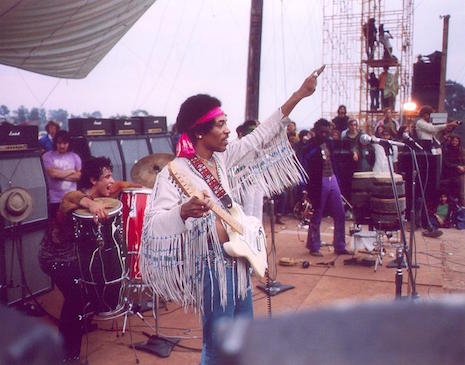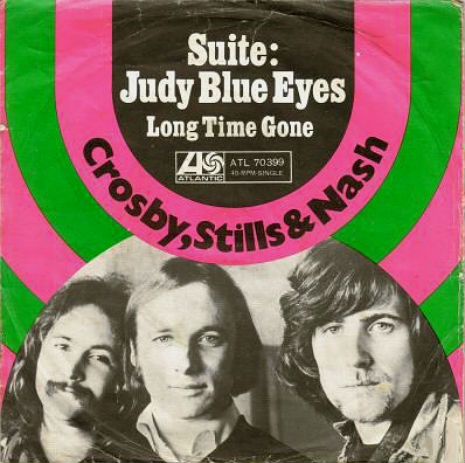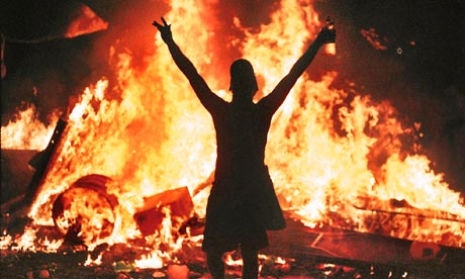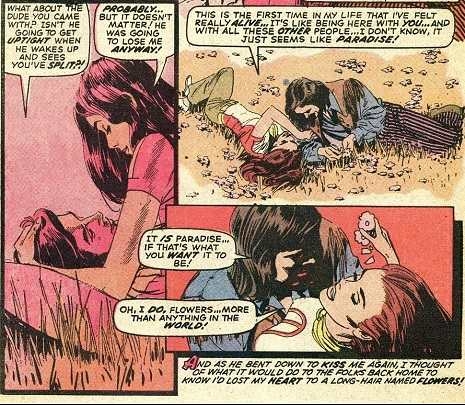
Below you can see an original ad for the Woodstock Music & Art Festival from the August 1969 issue of Ramparts Magazine and it’s riddled with bad information including the very location of the festival itself right around a month before the whole thing was supposed to go down. Woodstock, of course, opened on August 15th of that year.

Along with the major problem of not being right about where concert goers were supposed to show up, there were also some pretty significant omissions in the ad, showing that the list of performers wasn’t quite locked down a month in advance either. Performers not listed in the ad that actually did play Woodstock include Melanie, Bert Sommer, Quill, John Sebastian, Sly and the Family Stone, Country Joe and the Fish, Ten Years After, Paul Butterfield Blues Band and Sha Na Na.
As is stated in the ad, the original location for the festival was to be in Wallkill, NY. It was supposed to take place on the property of one Howard Mills who owned approximately 600 acres of land in the area that he eventually hoped to turn into an industrial complex. This according to the book Young Men with Unlimited Capital from 1974 written by Joel Rosenmen, John Roberts and Robert Pilpel, all planners, organizers and financiers for the event, not necessarily in that order. The book is an at times hilarious tome about the nail biting, often poorly thought-out process that led to the festival and the events on and after the legendary weekend. According to the book, Wallkill’s zoning board approved the festival on April 18th, 1969 but as the event grew nearer, the citizenry of Wallkill became increasingly concerned about the safety of their fair town if such an event were to take place. According to Young Men with Unlimited Capital, at the previously mentioned April zoning board meeting, Woodstock’s promoters were presented it as kind of an arts fair that would maybe draw forty or fifty thousand people if the event exceeded all attendance expectations. When asked what kind of music would be played, Joel Rosenmen supposedly responded with:
“I guess the best way to describe it would be, uh, folk. Basically folk. A little swing, too, maybe. A little jazz. You know.”
By July of 1969, however, some of the good people of Wallkill began to feel that they had essentially been duped, and, freaking out about the potential influx of drugs, the volume of the music, nudity and generally unsavory hippie behavior of all sorts, backed out on the deal.
Here’s a horizontal version of the above ad with the not-so-insignificant addition of Jimi Hendrix on the bill, but still listing the wrong location.
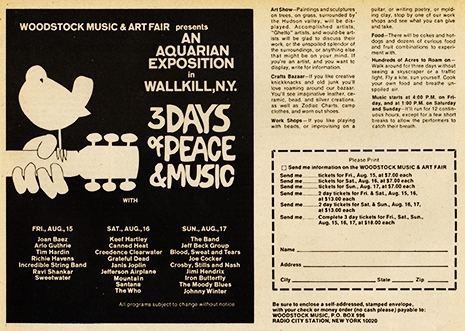
It’s amazing that the earlier ad didn’t even show that Hendrix was playing. Huge bonus if you already bought your eighteen-dollar weekend pass!
Musicians in both ads who didn’t end up playing include The Jeff Beck Group, Iron Butterfly and Moody Blues, so you were out of luck if you were planning on seeing any of those acts, I guess. The order of appearances in the ad is all out of whack as well, but the ad does state very clearly “All programs subject to change without notice.”
A “progress report” from Young Men with Unlimited Capital shows that a month before Woodstock things were indeed far from being in ship shape:
Progress (?) Report: July 15
Land: None
Staff: Same as June, give or take twenty people. Fifty construction workers redundant
Ticket Receipts: $537,123
Talent Bookings: Shaky
Attorneys: One in New York City for Woodstock Ventures; one in New York City for film and record contracts; on in Wallkill for suing; one in New York City for political influence; one in Liberty, New York for land acquisition
Portable Toilets: Another additional 500 ordered, for a total of 2,000
Money Spent: $481,519

After losing the Wallkill site so close to go-time and suddenly facing the prospect of having to hand out $500,000 in refunds, the event organizers were understandably panicked. But, once word got out that the deal in Wallkill had fallen through and people got wind of the kind of money involved, calls started rolling in with offers of land. John Roberts says in Young Men with Unlimited Capital that Max Yasgur, owner of the farm where the Woodstock Festival actually took place offered up his land without first being approached and by July 16th, they basically had their solid location in place again.
Not surprisingly, Joel Rosenman and John Roberts created a new ad once the final location was established and plastered it, according to Roberts, “for a week straight in every newspaper we could find.” The new ad depicted the people of Wallkill as reactionary, armed hayseeds and promised a lawsuit at a later date in retaliation for the last-minute change of plans.







